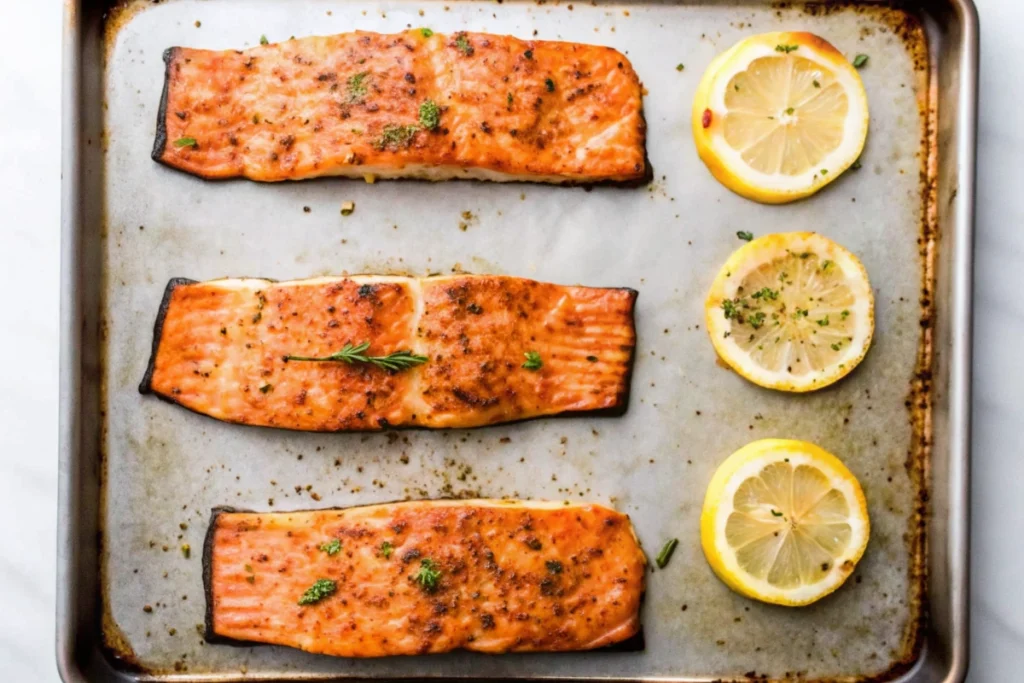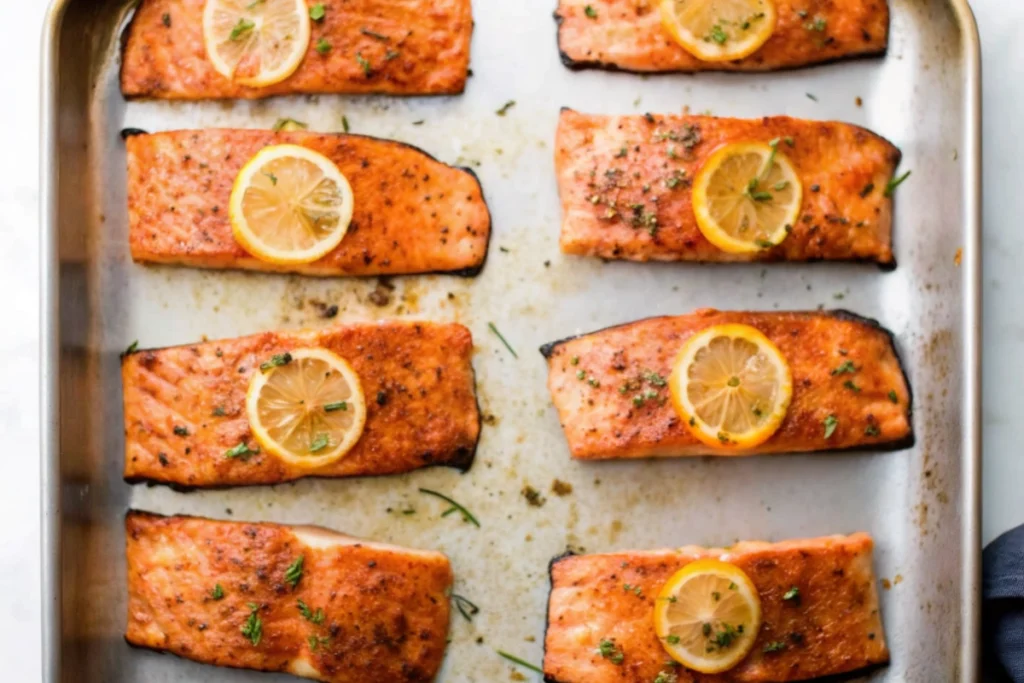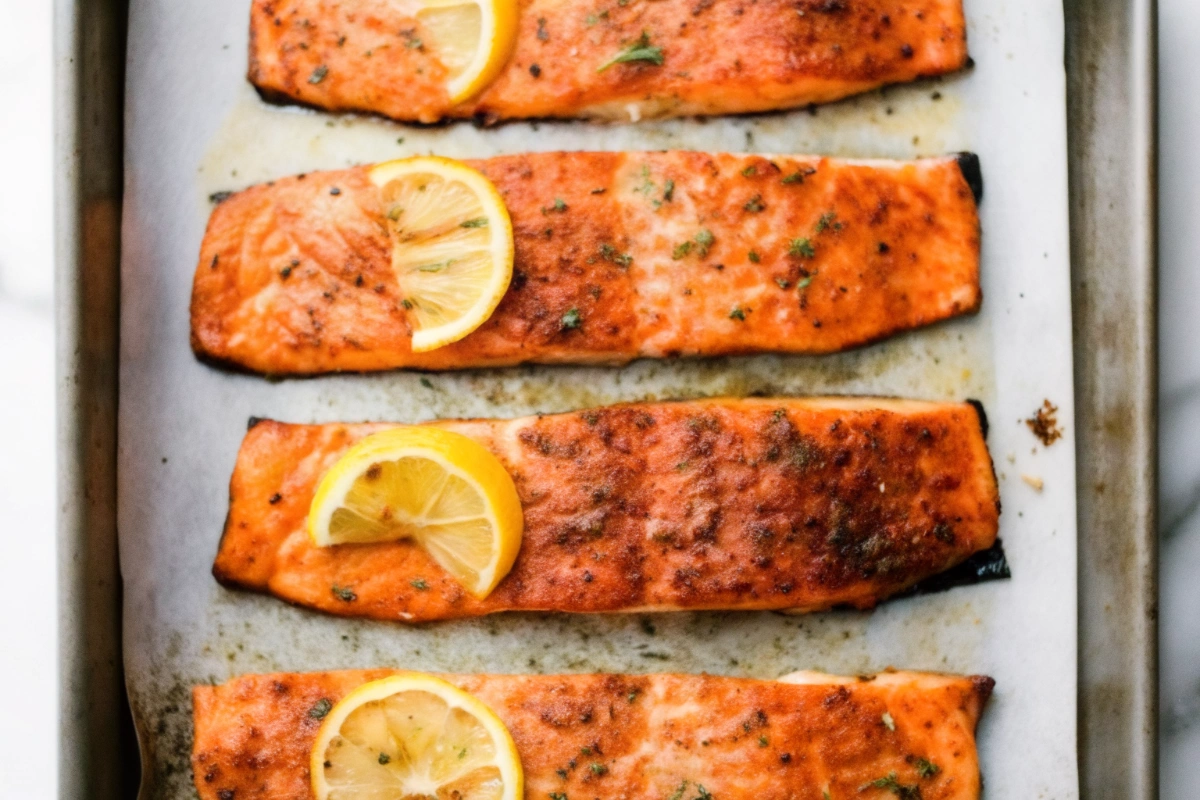Table of Contents: Baked Salmon
Table of Contents: Baked Salmon
Introduction
If you’re looking for a healthy, delicious dinner that’s simple enough for a weeknight yet impressive enough for guests, baked salmon is the go-to. Packed with flavor, loaded with nutrients, and surprisingly versatile, salmon is a staple for anyone aiming to eat well without sacrificing taste. Whether you’re wondering how long to bake salmon or what temperature brings out the best texture, this guide has everything you need.
You’ll discover the best techniques for baking salmon in the oven, how to pick the right cut, expert baking tips, and even how to reheat leftovers like a pro. We’ll also answer popular questions such as “Is it better to bake salmon at 350 or 400?” and provide you with a practical temperature chart for flawless results.
Check out this comforting chicken pot pie recipe for another warm and satisfying meal option.
Let’s dive into the flaky, juicy world of baked salmon!
Why Baked Salmon is a Favorite in American Kitchens
The Nutritional Power of Baked Salmon
Salmon isn’t just tasty—it’s a superfood. Rich in omega-3 fatty acids, high-quality protein, and essential vitamins like B12 and D, baked salmon helps support heart health, brain function, and glowing skin. For anyone looking to maintain a balanced diet, this fish hits the mark.
Why Baking is the Best Cooking Method
When it comes to cooking salmon, baking in the oven stands out for its ease and consistency. Unlike grilling or pan-searing, baking allows for hands-off cooking, less mess, and even heat distribution, ensuring your salmon remains moist inside with a slight crisp on the edges.
Taste and Texture Everyone Loves
Baked salmon offers a tender, flaky texture with a naturally rich flavor that pairs well with everything from citrus and herbs to spicy glazes. Its versatility is unmatched—make it Mediterranean-style, Asian-inspired, or classic lemon-garlic—it adapts beautifully.
Ideal for All Skill Levels
You don’t need to be a professional chef to bake perfect salmon. With just a few ingredients and a preheated oven, anyone can master this dish. Plus, it’s easy to batch-cook and perfect for meal prep.
How to Choose the Best Salmon for Baking
Wild vs. Farmed Salmon: Which Is Best?
Choosing between wild-caught and farmed salmon can affect both flavor and nutrition. Wild salmon typically has a deeper orange hue and a firmer texture. It’s leaner but richer in minerals and has a cleaner, more distinct taste. Farmed salmon, on the other hand, is milder in flavor and higher in fat content—making it more forgiving when baking but less nutrient-dense.
Ideal Cuts: Fillet, Steak, or Whole
For most baked salmon recipes, skin-on fillets are the go-to. They cook evenly, absorb marinades well, and the skin protects the flesh from drying. Salmon steaks offer a meatier bite but can be tricky due to bones. Whole salmon is ideal for large gatherings but needs more skill and oven space.
Fresh vs. Frozen Salmon
Frozen salmon can be just as good as fresh if it’s high-quality and properly thawed. Always pat it dry before seasoning to avoid excess moisture that can affect the baking process.
Baked Salmon Preparation Essentials
Cleaning and Prepping Your Salmon
Before seasoning, rinse your salmon under cold water and pat it dry with paper towels. This step is key to allowing seasonings and oils to adhere properly. If using frozen salmon, make sure it’s fully thawed overnight in the refrigerator.
Best Marinades, Spices, and Rubs
For bold flavor, try a lemon-garlic-dill marinade or a honey-soy glaze. Seasonings like paprika, cumin, and black pepper enhance depth. For a no-fail combo, drizzle olive oil, sprinkle sea salt, black pepper, and fresh rosemary over your fillets.
| Ingredient | Flavor Role |
|---|---|
| Lemon Juice | Bright acidity |
| Garlic | Aromatic richness |
| Olive Oil | Adds fat, prevents drying |
| Paprika | Earthy spice kick |
| Fresh Herbs | Fragrant, clean finish |
Discover great ideas like this Arroz con Leche dessert for the perfect end to your salmon dinner.
What’s the Best Temperature to Bake Salmon?
Baked Salmon at 350°F vs. 400°F
Baking salmon at 350°F yields gentle, even cooking and a tender texture. However, 400°F gives a slightly crispier exterior while maintaining juicy flesh inside. Use 350°F if you’re baking with sauces or foil. Choose 400°F when you want faster results with slightly caramelized edges.
Temperature Comparison Table
| Temperature | Time (per inch of thickness) | Result |
|---|---|---|
| 325°F | 25 minutes | Very soft, low browning |
| 350°F | 20-22 minutes | Moist, tender texture |
| 375°F | 18-20 minutes | Slight crisp on top |
| 400°F | 15-18 minutes | Crusty edge, juicy middle |
Cooking Times for Baked Salmon Explained
Baking Time Based on Thickness
A rule of thumb is 12-15 minutes per inch of thickness at 375°F. If you’re unsure, use a thermometer. Salmon is done when it reaches 145°F in the thickest part.
How Long to Bake Salmon at 350, 375, or 400?
- At 350°F: 20-25 minutes for standard fillets
- At 375°F: 15-20 minutes for 1-inch fillets
- At 400°F: 12-15 minutes, ideal for crisp tops
Looking for inspiration? Try this energizing coffee loophole recipe after your salmon dinner to power through the evening.
Oven Baked Salmon Methods & Variations

Foil-Wrapped vs Open-Pan Baking
Foil-wrapped baking locks in moisture and infuses flavor from herbs and marinades. It’s excellent for lemon or herb-based salmon. Open-pan baking allows edges to crisp and encourages browning, ideal for dry rubs or when cooking with veggies on the side.
Flavor Variations to Try
- Lemon Butter Salmon: Add lemon slices, garlic, and butter cubes
- Asian Glazed Salmon: Use soy sauce, honey, ginger, and sesame
- Herb-Crusted Salmon: Coat with Dijon mustard and chopped fresh herbs
Don’t miss our underrated Peanut Butter Cookie guide—a simple, sweet treat after dinner.
Common Mistakes When Baking Salmon
Overcooking and Undercooking
The most common mistake? Overbaking. It makes the salmon dry and crumbly. Always watch your timer and check internal temp. Undercooking leaves the middle raw—especially dangerous with thicker cuts.
Skin On or Skin Off?
Keep the skin on during baking—it helps retain moisture and prevents sticking. You can peel it off easily after baking if you prefer.
Forgetting to Rest
Rest your salmon for 5 minutes post-bake to let the juices redistribute. This keeps it tender and flavorful.
Serving and Side Dish Ideas for Baked Salmon
Go-To Side Dishes
- Garlic roasted asparagus
- Lemon herb quinoa
- Sweet potato mash
- Cucumber dill salad
These pair perfectly with the richness of baked salmon.
Presentation Tips
Serve salmon with the skin side down. Garnish with a lemon wedge and a sprig of dill. Use a large white plate for contrast and drizzle any leftover marinade on top.
Storage and Reheating Tips for Baked Salmon
Proper Storage
Store leftovers in an airtight container. Baked salmon lasts up to 3 days in the fridge. If freezing, wrap in foil then place in a freezer bag for up to 2 months.
How to Reheat Baked Salmon
Reheat at 275°F for 10-15 minutes, covered loosely with foil. This keeps it moist. Avoid microwaving, which dries out the fish and ruins texture.
FAQs About Baked Salmon

Is it better to bake salmon at 350 or 400?
Both temperatures work. Bake at 350°F for a soft texture or at 400°F for quicker cooking and a crispier edge.
How long does it take for salmon to cook at 400 degrees?
Generally, salmon takes 12-15 minutes to bake at 400°F, depending on thickness.
How do you cook salmon in the oven?
Preheat the oven to your desired temp (350–400°F), season the salmon, place on a baking sheet or in foil, and bake until it reaches an internal temperature of 145°F.
How long to cook salmon 375 in the oven?
Bake for 15–20 minutes at 375°F for fillets about 1-inch thick.
Conclusion
Baked salmon is one of the easiest, healthiest, and most rewarding meals you can make. With just a few ingredients, a hot oven, and this guide, you’ll consistently serve salmon that’s flavorful, juicy, and restaurant-worthy. Whether you prefer 350°F or 400°F, now you’ve got the tools to get it right every time.
Discover more easy dinner recipes with our comfort-packed Chicken Pot Pie recipe and transform your evenings!
Print
Baked Salmon Recipe Guide – The Best Way to Bake Perfect Salmon Every Time
- Total Time: 25 minutes
- Yield: 4 servings 1x
Description
Moist, flaky oven-baked salmon with a zesty garlic herb crust and fresh lemon slices – perfect for a healthy and flavorful dinner.
Ingredients
- 4 salmon fillets – about 6 ounces each
- 2 tablespoons olive oil
- ½ teaspoon salt – or to taste
- ¼ teaspoon cracked black pepper – just a pinch if using finely ground black pepper
- 2 teaspoons minced garlic
- 1 teaspoon Italian herb seasoning blend – OR herbs de provence, or ¼ teaspoon each dried thyme, parsley, oregano, and basil
- 1 medium lemon
Instructions
- Preheat oven to 400 degrees and grease a large baking pan.
- Arrange salmon fillets on the baking sheet and season generously with salt and pepper.
- Stir together olive oil, garlic, herbs, and juice of 1/2 lemon.
- Spoon over salmon fillets, rubbing all over the tops and sides so there are no dry spots.
- Thinly slice the remaining 1/2 of lemon and place a slice on top of each salmon fillet.
- Bake for 12-15 minutes until salmon is opaque and flakes easily with a fork.
- Broil for the last 1-2 minutes if desired for a crisp top.
- Garnish with fresh thyme or parsley if desired and serve.
Notes
You can substitute the herb blend to suit your taste. Great served with rice, roasted veggies, or a fresh salad.
- Prep Time: 10 minutes
- Cook Time: 15 minutes
- Category: Main Course
- Method: Baked
- Cuisine: American
Nutrition
- Serving Size: 1 fillet
- Calories: 350
- Sugar: 0g
- Sodium: 400mg
- Fat: 22g
- Saturated Fat: 4g
- Unsaturated Fat: 17g
- Trans Fat: 0g
- Carbohydrates: 1g
- Fiber: 0g
- Protein: 34g
- Cholesterol: 85mg
Keywords: baked salmon, healthy salmon, lemon garlic salmon, oven salmon

